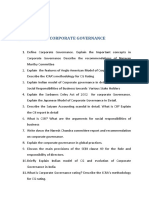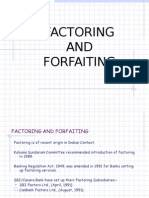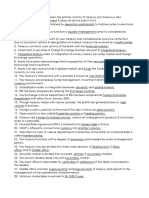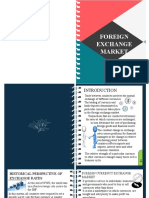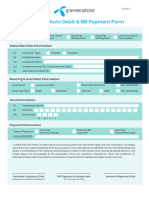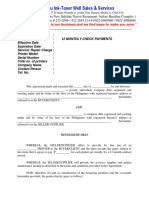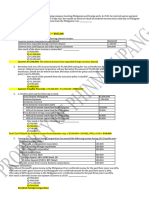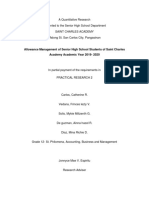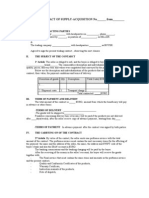15 International Working Capital Management: Chapter Objectives
15 International Working Capital Management: Chapter Objectives
Uploaded by
Nancy DsouzaCopyright:
Available Formats
15 International Working Capital Management: Chapter Objectives
15 International Working Capital Management: Chapter Objectives
Uploaded by
Nancy DsouzaOriginal Title
Copyright
Available Formats
Share this document
Did you find this document useful?
Is this content inappropriate?
Copyright:
Available Formats
15 International Working Capital Management: Chapter Objectives
15 International Working Capital Management: Chapter Objectives
Uploaded by
Nancy DsouzaCopyright:
Available Formats
15
International Working
Capital Management
Chapter Objectives
1. To describe the importance of working capital management and the constraints of
current asset management.
2. To list different channels available to move funds from one country to another.
3. To explain how MNCs can expedite the collection of funds and delay the
disbursements of funds.
4. To explain why MNCs centralize their cash management and how they invest
their excess funds.
5. To discuss accounts receivable management with a particular emphasis on
currency value problems.
6. To identify the inventory management problems faced by MNCs and the
techniques they can use to deal with these problems.
Chapter Outline
I. Basics of Working Capital Management
A. Working capital management refers to the management of current assets
and liabilities.
i. Domestic companies differ from multinational companies due to
the different business environment that they operate in.
ii. Working capital management can be viewed as a dynamic (flow)
or a static (stock) responsibility.
International Working Capital Management 201
iii. The basic objective is to determine the optimal amount of
investment in various current asset accounts, i.e. the level of
current asset holdings that maximizes the overall profitability of
the firm.
B. The importance of working capital management
i. It is important because it involves the largest portion of a financial
manager’s time.
ii. It is important because current assets represent more than half of
the total assets of most companies.
C. Literature on working capital management is limited because:
i. Decisions on working capital are relatively routine and frequent.
ii. Working capital decisions are easily reversible.
iii. Working capital management requires cash flow projections, and
the financial manager alone cannot forecast these. This means that
the financial aspects of the decision are sometimes concealed by
marketing (credit policy) and production (inventory management).
D. Net working capital funding is made up accounts receivable, inventory
levels, and accounts payable.
i. Cash and short-term debt are not included because they are not
spontaneous.
ii. MNCs attempt to minimize their net working capital.
1. MNCs should reduce the cycle until the marginal revenue
generated equals the marginal cost.
iii. Net working capital is typically computed on a days sales basis
using the following formula: days working capital = days
receivables + days inventory – days payables.
E. Economic constraints of current asset management
i. Foreign exchange constraints: international fund flows involve
foreign exchange transaction costs and exchange rate fluctuations.
ii. Regulatory constraints: these constraints can block dividend
repatriation or other forms of fund remittances.
iii. Tax constraints: these constraints limit the free flow of funds to a
parent or to sister affiliates.
iv. Other constraints: this includes inflation and interest rates.
F. Elements of international current asset management:
i. The ability to transfer funds – one of the most important
advantages that MNCs enjoy and one that can lead to conflicts
between MNCs and their host governments over the transfers
made.
ii. Positioning of funds – current asset management should position
working cash balances or excess liquidity amongst areas within an
MNC by focusing on the choice of country and the selection of
currency denomination.
iii. Arbitrage opportunities – MNCs have three different types of
arbitrage opportunities: 1) tax arbitrage, 2) financial market
arbitrage, and 3) regulatory system arbitrage.
International Working Capital Management 202
iv. There are different channels to move funds:
1. Fund flows from parent to subsidiary.
a. Largest flow is the initial investment.
b. Can also be loans or added investments.
c. Purchase of goods from the parent is another option.
2. Fund flows from subsidiary to parent.
a. The flow of funds consists of dividends, interest on
loans, principal reduction payments, royalty
payments, license fees, technical services fees,
management fees, export commissions, and
payment for goods received from the parent.
b. Parents do not have total control over the size of the
flow of funds because of external factors such as
foreign exchange controls and tax constraints.
3. Fund flows from subsidiary to subsidiary.
a. The flow of funds consists of loans to each other or
the buying of goods.
b. Funds from one subsidiary may be used to establish
another.
G. There are many different methods to transfer funds:
i. Multilateral netting, i.e. highly coordinated interchange of
material, parts, work-in-process, and finished goods among various
units. Netting is a method designed to reduce foreign exchange
transaction cost through the consolidation of account payables and
accounts receivable.
ii. MNCs can accelerate (lead) or delay (lag) the timing of foreign-
currency payments in order to reduce foreign exchange exposure
or to increase working capital available. This technique has a
number of advantages over direct loans:
1. Leading and lagging do not require a note that officially
recognizes an obligation to the seller and the amount of
credit can be adjusted up or down by shortening or
lengthening the credit terms.
2. Indications are that governments interfere less with
payment on intracompany accounts than on intracompany
loans.
3. Under Section 482 of the U.S. tax code, U.S. firms do not
have to pay interest on intracompany accounts up to size
months, but they have to pay interest on all intracompany
loans.
iii. Transfer prices are prices of goods and services sold between
related parties such as a parent and its subsidiary.
1. Transfer prices are frequently different from arm’s length
prices (fair market prices), and this leaves room for
manipulation.
International Working Capital Management 203
2. Transfer prices can be manipulated to reduce or avoid
taxes, affect direct cash flows for payments of goods and
taxes, for cost structure, and for the evaluation of
management performance.
3. Transfer prices can avoid financial problems or improve
financial conditions.
4. A major consideration in setting a transfer price is the
income tax effect.
iv. Reinvoicing centers can be set up in tax haven countries to bypass
or circumvent governmental restrictions and regulations.
1. Tax haven countries are those nations that provide foreign
companies with permanent tax inducements.
2. In June 2000, the Organization for Economic Cooperation
and Development (OECD) named 35 jurisdictions whose
status as tax havens poses potentially harmful tax
competition.
a. These 35 jurisdictions needed to specify how and
when they would bring their tax regimes into line
with international standards.
b. Those that did not comply would face defensive
measures.
3. Reinvoicing centers are often used to cope with foreign
exchange exposures.
v. Intracompany loans are another methods to transfer funds.
1. A credit swap is a simultaneous spot-and-forward loan
transaction between a private company and a bank of a
foreign country.
a. There are really intracompany loans hedged and
channeled through banks.
2. Parallel loans consist of two related but separate
borrowings and typically involve four parties in two
different countries.
a. Parallel loans are frequently used to effectively
repatriate blocked funds by circumventing exchange
control restrictions.
vi. The various payments by foreign subsidiaries to the parent
company can be adjusted.
1. Dividends payments may be manipulated using the
following two methods both based on inflated the value of
the local investment base because the level of dividend
payments depends on the company’s capital:
a. The parent company can magnify its subsidiary’s
registered capital by investing in used equipment
whose value has been artificially inflated.
b. The parent company may acquire a bankrupt local
firm at a large discount from book value and then
International Working Capital Management 204
merge it with its subsidiary on the basis of the failed
firm’s book value.
2. Royalties and fees are more easily manipulated than
dividend payments therefore MNCs can inflate these
payments to transfer funds.
vii. MNCs frequently unbundled remittances into separate flows for
such purposes as royalties and management fees rather than lump
all flows under the heading of profit (dividend).
1. Unbundling makes it possible for MNCs to recover funds
from their affiliates without irritating host country
sensitivities with large dividend drains.
2. MNCs can also unbundled remittances into separate cash
flows to reduce their overall income taxes.
II. Objectives of Cash Management
A. Cash gives MNCs the ability to pay bills as they come due, but it is not an
earning asset making it very important to determine the optimal level of
investment in cash.
B. The major sources of cash inflows are dividends, royalties and fees, cash
sales and collections on accounts receivable, depreciation, sales of new
securities, loans from banks or nonblank financial institutions, and
advance cash payments on contracts.
C. The major sources of cash outflows are interest and dividend payments,
retirement of debt and other securities, income tax payments, payments on
accounts payable, wages and salaries, and purchases of fixed assets.
D. There are three motives for holding cash rather than other forms of assets:
i. The transactions motive holds that cash balances are held partly in
anticipation of day-to-day cash disbursements.
ii. The precautionary motive holds that cash balances are held partly
as protection against deviations from budgeted cash flows.
iii. The speculative motive holds that cash balances are held partly in
order to take advantage of profit-making opportunities.
E. The overall cash management objective of any corporation, domestic or
international, is to minimize the cash balance within the company with the
goal of optimizing corporate fund utilization.
i. The parameters within which MNCs operate are broader and more
complex than those of domestic companies.
ii. International cash managers try to attain the traditional objectives
of domestic cash management on a global basis:
1. To minimize the cost of funds, especially with high interest
rates in many countries.
2. Improve liquidity on a global basis.
3. To reduce political, economic, and exchange risks through
thing such as insurance, careful negotiations, forward
contracts, and currency options.
International Working Capital Management 205
4. To improve the return on investment through careful
consideration of return on investment and return on net
worth.
F. The steady flow of funds among MNCs family members has the problem
of float, i.e. the status of funds in the process of collection. There are five
categories of float:
i. Invoicing float refers to funds tied up in the process of preparing
invoices.
1. This float is largely under the direct control of the company
and can be reduced through more efficient clerical
procedures.
ii. Mail float includes funds tied up from the time customers mail
their remittance checks until the company receives them
iii. Processing float consists of funds tied up in the process of sorting
and recording remittance checks until they can be deposited in the
bank.
1. This float is under the company’s internal control and can
be reduced through more efficient clerical procedures.
iv. Transit float involves funds tied up from the time remittance
checks are deposited until these funds become usable to the
company.
v. Disbursing float refers to funds available in a company’s bank
account until these funds are actually disbursed by the company.
vi. In international operations, float leads to two problems:
1. The loss of income on the funds tied up during the longer
transfer process.
2. Their exposure to foreign exchange risk during the transfer
period.
G. The overall efficiency of international cash management depends on
various collection and disbursement policies, i.e. collection should be
accelerated and payment delayed.
i. Acceleration of collections – the principal goals are to reduce
floats, to minimize the investment in accounts receivable, and to
reduce banking and other transaction fees.
ii. Delay of payments – this can be done using mail, more frequent
requisitions and floats.
H. The cost of cash management comes from the cost of accelerating
collections and delaying disbursements.
i. In theory, a company should adopt various collection and
disbursement methods as long as their marginal returns exceed
their marginal expenses.
ii. The value of careful cash management depends on the opportunity
cost of funds invested in cash.
I. Cash management can be centralized, regionalized, or decentralized.
i. Decentralization permits subsidiaries to use excess cash in any way
they see fit.
International Working Capital Management 206
1. Decentralization does not allow an MNC to utilize its most
liquid asset on a widespread basis.
ii. Centralized cash management or cash pooling calls for each local
subsidiary to hold at the local level the minimum cash balance for
transaction purposes.
1. All funds not needed for transaction purposes are channeled
to a central cash center.
2. The cash center is responsible for placing a central pool of
funds in those currencies and money market instruments
that will best serve the needs of the MNC on a worldwide
basis.
iii. There are a number of advantages to centralized cash management
over decentralized cash management:
1. The central cash center can collect information more
quickly and make better decisions on the relative strengths
and weaknesses of various currencies.
2. Funds held in a cash center can quickly be returned to a
subsidiary with cash shortages via wire transfer or by
providing a worldwide banking system with full collateral
in hard currency.
a. It eliminates the possibility that one subsidiary will
borrow at higher rates while another holds surplus
funds idle or invests them at lower rates.
3. By holding all precautionary balances in a central cash
center, an MNC can reduce the total pool without any loss
in the level of production. This is due to a synergistic
effect that is said to exist when the whole is worth more
than the mere sum of its parts.
iv. The proper assessment of local cash needs in relation to the cash
center involves the following steps:
1. Cash budgets should be prepared to know anticipated cash
outflows and inflows at key future dates.
2. Each subsidiary must have effective cash collection
procedures that will speed cash flows into the company.
3. Each subsidiary must have systematic cash disbursement
procedures that will delay cash flows out of the company.
4. Each subsidiary should estimate when and how much
surplus cash it will have.
5. Each subsidiary should estimate when and how much
shortages it will have.
6. The MNC must develop necessary steps for cash
mobilization such as a management information system and
cash transfer system; it should have the clear responsibility
for making cash transfer decisions.
v. The location of cash centers are effects by the following factors:
International Working Capital Management 207
1. The local government’s stability and its attitude toward
foreign-based companies.
2. The stability of the local exchange rate, the ease with which
it can be converted into other currencies, and the existence
of a local forward market and money market instruments.
3. Access to international communications and well-defined
legal procedures.
J. International cash management also involves the wise investment of
excess funds.
i. There are three types of portfolio management available to
international cash managers:
1. A zero portfolio where all excess funds of subsidiaries are
remitted to the parent and then used to pay the parent’s
short-term debts.
2. Cash management can be centralized in third countries such
as tax haven countries.
3. Cash management can be centralized at headquarters with
subsidiaries holding only minimum amounts of cash for
transactions purposes.
ii. If MNCs invest funds in marketable securities such as Treasury
bills, they should follow sound portfolio guidelines:
1. Instruments in the short-term investment portfolio should
be diversified to maximize yield for a given amount of risk
or to minimize risk for a given amount of return.
2. For companies that hold marketable securities for near-
future needs of liquidity, marketability considerations are
of major importance.
3. The maturity of the investment should be tailored to the
company’s projected cash needs.
4. The securities chosen should be limited to those with a
minimum risk of default.
5. The portfolio should be reviewed daily to decide what new
investments will be made and which securities will be
liquidated.
K. A survey in 1996 of Fortune 200 companies found the following regarding
the use of cash-management techniques:
i. Wire transfers were used most often (82.3), followed by cash
pooling (50.0%), netting (49.6%), electronic fund transfers
(49.6%), and lock boxes (28.7%).
III. Accounts Receivable Management
A. The level of accounts receivable depends upon the volume of credit sales
and the average credit period and these two variables depend upon credit
standards, credit terms, and collection policy. Accounts receivable have a
cost in terms of foregone interest.
International Working Capital Management 208
B. MNCs have problem with currency value changes and the account
receivable managers should take actions to reduce this risk, either through
currency denomination or the use of factors.
i. The seller may require that payments be made in currencies likely
to face little or no devaluation.
ii. Factoring is a process whereby a company sells its account
receivable on a nonrecourse basis.
1. The factor bear risk and performs services such as credit
checking, bookkeeping, and the collection of accounts.
C. Management of account receivable from independent buyers involves two
types of decisions:
i. The denomination of currency to be used for payment.
ii. The terms of payment.
D. Management of account receivable from intracompany sales differ from
sales to independent buyers in that little concern is given to credit standing
and that the timing of the payments may depend upon a company’s desire
to allocate resources rather than normal payment schedules.
IV. Inventory Management
A. Inventory management is important for two reasons:
i. Inventories represent a significant segment of total assets for most
MNCs.
ii. Inventories are the least liquid of current assets, thus, errors in
inventory management are not quickly remedied.
B. Many companies have adopted the just-in-time inventory system, and this
system requires that when orders are placed, specific goods are ordered
along with an exact delivery date.
i. The goal is to reduce inventory balances to practically zero.
ii. Often, under this system, suppliers build companies close to their
major customers.
C. Determining the amount of inventory:
i. The level of sales, the length of the production cycle, and the
durability of the product are the major determinants of investment
in inventory.
1. Differentials in the costs of production and storage in
different countries allow MNCs to maintain more flexible
inventory policies than domestic firms.
ii. A key decision is whether to buy inventory in advance or to delay
purchase:
1. Advance purchases involve such carrying costs as interest
on funds tied up in inventory, insurance premiums, storage
costs, and taxes.
2. Later purchases increase the possibility of higher costs
either due to inflation or devaluation.
D. Many MNCs operate under inflationary economic conditions and this
affects inventory management policies.
International Working Capital Management 209
i. One key question is whether to use imported or locally acquired
inventories, or a balance of both.
1. If imports are used, inventories should be built up before an
expected devaluation.
2. If local goods are used, inventory should be minimized.
3. If a balance is used, locally acquired goods should be
reduced and imports should be increased.
E. Pricing can also be a method to reduce risks associated with devaluation.
Key Terms and Concepts
Working Capital Management is the management of current assets and current
liabilities.
Netting is a method designed to reduce the foreign exchange transaction cost through the
consolidation of accounts payables and accounts receivable.
Leads and Lags are respectively acceleration and delay of the timing of foreign currency
payments in order to reduce the foreign exchange exposure or to increase working capital
available.
Transfer Prices are prices of goods and services sold between related parties such a
parent and its subsidiary.
Credit Swap is a simultaneous spot-and-forward loan transaction between a private
company and a bank of a foreign country.
Transaction Motive holds that cash balances are held partly in anticipation of day-to-day
cash disbursements.
Precautionary Motive suggests that cash balances are held partly against deviations
from budgeted cash flows.
Speculative Motive relates to the holding of cash in order to take advantage of profit
making opportunities.
Float refers to the status of funds in the process of collection.
Factoring is a process whereby a company sells its accounts receivable on a non-
resource basis.
Just-in-time Inventory System is a Japanese inventory system that strives to reduce
inventory balances to almost zero.
International Working Capital Management 210
Multiple Choice Questions
1. The fund which cannot be repatriated to their parent company by foreign subsidiaries
is called .
A. a black market fund
B. a government fund
C. a special fund
D. a mutual fund
E. a blocked fund
2. The ability to relocate working cash balances and profits on a global basis provides
multinational firms with several types of arbitrage opportunities. These types of
arbitrage opportunities do not include arbitrage.
A. tax
B. financial market
C. regulatory system
D. commodity market
E. both A and B
3. Fund flows from parent to subsidiary do not include .
A. the initial investment from the parent
B. intracompany loans from the parent
C. the credit purchase of goods from the parent
D. the purchase of management services from the parent
E. the transfer of employees from the parent
4. Which of the following is not a major component of fund flows from subsidiary to
parent?
A. dividend payments from subsidiary
B. interest payments from subsidiary
C. royalty payments from subsidiary
D. payments for goods received from the parent
E. tax payments from subsidiary
5. An advantage of multilateral netting by a multinational corporation and its foreign
affiliates is that it .
A. reduces the total volume of interaffiliate fund flows
B. increases the total volume of interaffiliate fund flows
C. increases foreign exchange risk
D. increases political risk
E. reduces the number of employees
6. Leads and lags are a form of working capital management by .
A. accelerating hard-currency payables payments and delaying soft-currency
payables payments
International Working Capital Management 211
B. delaying accounts receivable payments and speeding up accounts payable
payments
C. accelerating both receivables and payables payments
D. accelerating soft-currency payables payments and accelerating hard-currency
payables payments
E. all of the above
7. According to the transfer pricing regulations, multinational firms are supposed to
charge prices to its foreign affiliates based on the following:
A. total cost
B. arm's-length prices
C. average cost
D. internal prices
E. none of the above
8. Some multinational companies set up a re-invoicing center which normally .
A. invoices in the same currency for the buyer and seller of goods and services
B. buys in one currency and pays in another currency
C. buys in the parent currency and pays in the parent currency
D. buys in gold and pays in the U.S. dollar
E. all of the above
9. Intracompany loans do not include the following transaction(s) .
A. direct loans
B. credit swaps
C. back to back loans
D. both B and C
E. currency swaps
10. Credit swaps do not include the following party .
A. the parent company
B. the foreign company
C. a bank
D. a foreign government
E. both A and B
11. Multinational firms may be able to repatriate funds from foreign affiliates through the
following method(s) .
A. royalty payments
B. management fees
C. dividend payments
D. adjustment of transfer prices
E. all of the above
12. Which of the following is not related to the traditional objectives of multinational
firms' cash management?
International Working Capital Management 212
A. to minimize the cost of funds
B. to improve liquidity
C. to improve the return on investment
D. to reduce risks
E. to pay the same amount of dividend year after year
13. Centralized international cash management requires each local subsidiary to .
A. do whatever it wants with its excess cash
B. hold the minimum cash balance
C. invest in foreign exchange markets
D. invest in local capital markets
E. invest in long-term securities
14. The most important factor affecting the location of international cash centers is
probably .
A. the local government's political stability and its attitude toward foreign-based
companies
B. having enough cash balances at the local subsidiary
C. exchange rate volatility
D. the local government's ability to export oil
E. all of the above
15. Major categories of a float do not include the following ___ .
A. invoicing float
B. credit float
C. mail float
D. processing float
E. transit float
16. The "just-in-time" inventory management was initiated by .
A. the United States
B. Germany
C. Japan
D. the United Kingdom
E. Korea
17. A 1996 study by Ricci and Morrison found that 80 percent of Fortune 200 companies
use wire transfers , 50 percent poor their cash , and almost half net payments
and transfer funds electronically .
A. sometimes; sometimes; sometimes
B. often; often; often.
C. often; sometimes; rarely.
D. rarely; rarely; rarely.
E. often; often; rarely.
International Working Capital Management 213
18. Transfer pricing has been used by multinational firms to achieve the following
objectives:
A. minimize income taxes
B. minimize tariff payments
C. minimize foreign exchange controls
D. operate working capital effectively
E. all of the above
19. Re-invoicing centers are set up in tax haven countries to do the following .
A. charge higher prices
B. meet different accounting standards
C. bypass government restrictions and/or avoid taxes
D. A and B
E. A, B, and C
20. Multinational companies frequently unbundle remittances into separate flow
categories in order to .
A. avoid taxes
B. minimize the size of profit repatriation
C. meet the accounting standards
D. A and B
E. A, B, and C
21. Which of the following is not a popular cash center location.
A. Luxembourg
B. The Netherlands
C. Bermuda
D. Chile
E. the Bahamas
22. Intracompany loans do not include .
A. direct loans
B. credit swaps
C. back to back loans
D. loans under parent guarantees
E. loans from the World Bank
23. In international cash management, which of the following items is most important?
A. interest rate differential between two countries
B. inflation differential between two countries
C. interest rate and foreign exchange rate comparisons between two countries
D. A and B
E. A, B, and C
24. Which of the following is not one of the ways that a multinational company can delay
its payments?
International Working Capital Management 214
A. mail
B. electronic fund transfers
C. more frequent requisitions
D. floats
E. none of the above
25. The difference between European and American companies regarding working
capital is:
A. European companies have a considerably higher level of net working capital than
US companies due to support the same level of sales.
B. European companies have a considerably lower level of net working capital than
US companies due to support the same level of sales.
C. there are no noticeable differences regarding working capital.
D. US companies have higher levels of net working capital but this is used to support
a higher level of sales.
E. European companies have higher levels of net working capital but this is used to
support a higher level of sales.
26. There is little literature on working capital management because:
A. decisions on working capital are relatively routine and frequent.
B. working capital decisions are easily reversible
C. working capital management requires cash flow projections and these cannot be be
forecasted by the financial manager alone
D. A and B
E. A, B and C
27. A U.S. company has $10,000 in cash available for 45 days. It can earn 1 percent on
45-day investment in the United States. Alternatively, if it converts the dollars to
German marks, it can earn 1.5 percent on a German deposit for 45 days. The spot rate
of the German mark is $0.50. The spot rate 45 days from now is expected to be $0.40.
Should this company invest its cash in the United States or in Germany?
A. In the United States
B. In the Germany
C. It does not make any difference
D. All of the above
E. None of the above
28. A German investor has DM100,000 to invest for one year. U.S. Treasury bills offer a
yield of 11 percent. The current exchange rate of the mark is $0.50. What is the yield
on the investment if the exchange rate of the mark is $0.46 at the end of the year?
A. 10.25%
B. 12.55%
C. 15.00%
D. 20.65%
E. 25.00%
International Working Capital Management 215
Answers
Multiple Choice Questions
1. E 11. E 21. D
2. D 12. E 22. E
3. E 13. B 23. C
4. E 14. A 24. B
5. A 15. B 25. A
6. A 16. C 26. E
7. B 17. B 27. A
8. B 18. E 28. D
9. E 19. C
10. D 20. A
Solutions
27. Solution:
U.S. investment earns 1 percent.
Percentage change in mark = ($0.40 - $0.50)/$0.50 = -20%.
German investment loses 18.8 percent: [(1 + 0.015)(1 + (-0.20)] - 1 = -18.8%.
28. Solution:
Convert DM100,000 to $50,000 at $0.50 rate.
Invest $50,000 in the U.S. at 11 percent.
($50,000 x 1.11 = $55,500)
Reconvert dollars to marks.
($55,500/$0.46 = DM120,652)
Yield = (DM120,652 - DM100,000)/DM100,000 = 20.65%.
International Working Capital Management 216
You might also like
- Asset Allocation 5E (PB): Balancing Financial Risk, Fifth EditionFrom EverandAsset Allocation 5E (PB): Balancing Financial Risk, Fifth EditionRating: 4 out of 5 stars4/5 (13)
- Account Summary: 1-800-427-2200 EnglishDocument2 pagesAccount Summary: 1-800-427-2200 Englishytprem aguNo ratings yet
- Electronic Payment Systems For E-Commerce (2002)Document360 pagesElectronic Payment Systems For E-Commerce (2002)Trà MộcNo ratings yet
- Deutsche Bank MT940/942 Format Specifi CationsDocument18 pagesDeutsche Bank MT940/942 Format Specifi CationsfcfarabiNo ratings yet
- Account Summary Payment Information: New Balance $1,102.59Document6 pagesAccount Summary Payment Information: New Balance $1,102.59Nhan NguyenNo ratings yet
- Core Risks in BankingDocument9 pagesCore Risks in BankingVenkatsubramanian R Iyer100% (1)
- International Financial PPT PpresentationDocument41 pagesInternational Financial PPT PpresentationSambeet ParidaNo ratings yet
- Currency Exposure ManagementDocument52 pagesCurrency Exposure ManagementBernardCharo100% (1)
- Ifim Unit 1 - NotesDocument17 pagesIfim Unit 1 - NotesJyot DhamiNo ratings yet
- Unit 1 Introdution To BankingDocument2 pagesUnit 1 Introdution To Bankingaakash patil100% (1)
- Tandon CommitteeDocument6 pagesTandon CommitteeSakthi Priyadharshini MNo ratings yet
- Portfolio TheoryDocument6 pagesPortfolio TheorykrgitNo ratings yet
- Chapter 7 Why Do Financial Institutions ExistDocument10 pagesChapter 7 Why Do Financial Institutions ExistJay Ann DomeNo ratings yet
- Debt MarketDocument20 pagesDebt Marketnishantbali100% (3)
- Evolution of Financial SystemDocument12 pagesEvolution of Financial SystemGautam JayasuryaNo ratings yet
- Stock Valuation - Financial ManagementDocument10 pagesStock Valuation - Financial ManagementNoelia Mc DonaldNo ratings yet
- A 2 - Roles and Functions of Various Participants in Financial MarketDocument2 pagesA 2 - Roles and Functions of Various Participants in Financial MarketOsheen Singh100% (1)
- The Secondary MarketDocument13 pagesThe Secondary MarketDhushor SalimNo ratings yet
- Cash Management ServicesDocument5 pagesCash Management ServicesMadhur AnandNo ratings yet
- Camel RatingsDocument19 pagesCamel RatingsVikas R GaddaleNo ratings yet
- Unit 2 Financial System and Its ComponenetsDocument54 pagesUnit 2 Financial System and Its Componenetsaishwarya raikar100% (1)
- What Is A "Derivative" ?Document4 pagesWhat Is A "Derivative" ?RAHULNo ratings yet
- Commercial BankDocument11 pagesCommercial BankVaibhavi BorhadeNo ratings yet
- Questions of Corporate GovernanceDocument6 pagesQuestions of Corporate GovernanceVrushali Thobhani100% (1)
- Money MarketDocument7 pagesMoney MarketNiraj Arun ThakkarNo ratings yet
- Types of MergerDocument27 pagesTypes of MergerShanskriti SwainNo ratings yet
- Monetary POLICYDocument21 pagesMonetary POLICYSrishti VasdevNo ratings yet
- Bank and Banking PerspectiveDocument10 pagesBank and Banking PerspectiveDennilyn TanchicoNo ratings yet
- 53177137-Securitization-Ppt 1Document23 pages53177137-Securitization-Ppt 1kimmiahujaNo ratings yet
- UnderwriterDocument23 pagesUnderwritervarunsingh88No ratings yet
- Capital Structure TheoriesDocument9 pagesCapital Structure TheoriesMahesh HadapadNo ratings yet
- Tandon Committee Report On Working CapitalDocument4 pagesTandon Committee Report On Working CapitalMohitAhuja100% (1)
- Capital MarketDocument12 pagesCapital MarketDonna MarcialNo ratings yet
- External Sources of FinanceDocument18 pagesExternal Sources of FinanceMonika ThakurNo ratings yet
- Capital Structure and Dividend TheoriesDocument16 pagesCapital Structure and Dividend Theoriesmusa_scorpionNo ratings yet
- SecuritisationDocument11 pagesSecuritisationamu231286No ratings yet
- Module 1 Introduction To The Capital Market Ethiopian ContextDocument7 pagesModule 1 Introduction To The Capital Market Ethiopian ContextSamueEfrem100% (1)
- Factoring and ForfaitingDocument34 pagesFactoring and ForfaitingCharu ModiNo ratings yet
- Buyback of Shares by Reliance Industries: Presented B Anisa Ali Amritanshu Mishant Anita Singh Arghya DasDocument13 pagesBuyback of Shares by Reliance Industries: Presented B Anisa Ali Amritanshu Mishant Anita Singh Arghya DasPrince SachdevaNo ratings yet
- Money MarketDocument20 pagesMoney Marketmanisha guptaNo ratings yet
- Unit-12 Liquidity Vs ProfitabilityDocument14 pagesUnit-12 Liquidity Vs ProfitabilityKusum JaiswalNo ratings yet
- Sources of FinanceDocument33 pagesSources of FinanceAneesh SajiNo ratings yet
- Theories of CapitalizationDocument22 pagesTheories of CapitalizationANURAG SHARMA 19111507No ratings yet
- Parity Conditions in International FinanceDocument68 pagesParity Conditions in International FinanceGaurav Kumar100% (2)
- Mergers and AcquisitionsDocument34 pagesMergers and Acquisitionseknath2000No ratings yet
- Answers To End of Chapter Questions: Chapter 3: International Financial MarketsDocument5 pagesAnswers To End of Chapter Questions: Chapter 3: International Financial MarketsNgan Nguyen100% (1)
- Global Portfolio ManagementDocument15 pagesGlobal Portfolio ManagementCheery Mea CostillasNo ratings yet
- MFS Module 1Document89 pagesMFS Module 1Navleen KaurNo ratings yet
- Money MarketDocument37 pagesMoney MarketShaishav BhesaniaNo ratings yet
- Security Analysis and Portfolio Management Unit-1 InvestmentDocument27 pagesSecurity Analysis and Portfolio Management Unit-1 InvestmentMadhu dollyNo ratings yet
- Ch.2-Primary, Secondary & Debt MarketDocument78 pagesCh.2-Primary, Secondary & Debt MarketjaludaxNo ratings yet
- Treasury ManagementDocument10 pagesTreasury ManagementSankar RajagopalNo ratings yet
- Edoc - Tips Ch01 Financial Markets Money MarketDocument12 pagesEdoc - Tips Ch01 Financial Markets Money MarketKelvin LeongNo ratings yet
- Islamic Money MarketDocument3 pagesIslamic Money MarketALINo ratings yet
- Foreign Exchange MarketDocument12 pagesForeign Exchange MarketJoksmer MajorNo ratings yet
- Techniques For Managing ExposureDocument26 pagesTechniques For Managing Exposureprasanthgeni22100% (1)
- Transaction Exposure-TechniquesDocument16 pagesTransaction Exposure-TechniquesMital ParmarNo ratings yet
- CH3 - Financial Report StandardsDocument38 pagesCH3 - Financial Report StandardsStudent Sokha ChanchesdaNo ratings yet
- International Working Capital ManagementDocument16 pagesInternational Working Capital ManagementSumant Kumar80% (10)
- Buybacks and DelistingDocument23 pagesBuybacks and DelistingKushal Adeshra100% (2)
- Cross Cultural NegotiationDocument14 pagesCross Cultural NegotiationNeha RawatNo ratings yet
- Primary MarketDocument27 pagesPrimary MarketMrunal Chetan Josih0% (1)
- Foundations of Multinational Financial Management: Alan Shapiro John Wiley & SonsDocument30 pagesFoundations of Multinational Financial Management: Alan Shapiro John Wiley & SonssonaliNo ratings yet
- Invoice Block (Tolerance Limit)Document5 pagesInvoice Block (Tolerance Limit)lucky2340100% (1)
- Roaming Activation FormDocument2 pagesRoaming Activation FormASIF AHMEDNo ratings yet
- 12 Month Bank StatementDocument31 pages12 Month Bank Statementhalimbenbahmed0640No ratings yet
- Free Printer Contract - RevisedDocument2 pagesFree Printer Contract - Revisedbrayan uyNo ratings yet
- Code of Conduct Farmasi PDFDocument38 pagesCode of Conduct Farmasi PDFSyifa MustikaNo ratings yet
- PPTC 190Document9 pagesPPTC 190odufghodNo ratings yet
- Income Tax Department: Computerized Payment Receipt (CPR - It)Document2 pagesIncome Tax Department: Computerized Payment Receipt (CPR - It)Mian EnterprisesNo ratings yet
- GST ProjectDocument19 pagesGST ProjectPreeti HiraskerNo ratings yet
- BAM031 - P2 - Q2 - Introduction To Gross Income, Inclusions and Exclusions - AnswersDocument8 pagesBAM031 - P2 - Q2 - Introduction To Gross Income, Inclusions and Exclusions - AnswersShane QuintoNo ratings yet
- Disbursement Voucher: Philippine Coast GuardDocument1 pageDisbursement Voucher: Philippine Coast GuardJona Jane VerdidaNo ratings yet
- Allowance Management of Senior High School in Saint Charles AcademyDocument29 pagesAllowance Management of Senior High School in Saint Charles AcademyMykie Milizenth100% (3)
- B EMI StrategyDocument5 pagesB EMI StrategyAnestis FilopoulosNo ratings yet
- MPT and MOT Bulletin 2024Document16 pagesMPT and MOT Bulletin 2024Shaina Hayat KhanNo ratings yet
- Kerala State Electricity Board LTD.: Notice Inviting Tender (Re-E-Tender) Re-e-TENDER No.: CEPED/04/2020-21Document3 pagesKerala State Electricity Board LTD.: Notice Inviting Tender (Re-E-Tender) Re-e-TENDER No.: CEPED/04/2020-21PriyankaNo ratings yet
- CDR October 2018Document24 pagesCDR October 2018Marcy Delfino AcabNo ratings yet
- Disclaimer XYZ HotelDocument2 pagesDisclaimer XYZ Hotel59-Bushra Binte SayedNo ratings yet
- Narrative ReportDocument3 pagesNarrative ReportKrissie Jane MorinNo ratings yet
- Applicant'S Copy: PUPCET 2015Document2 pagesApplicant'S Copy: PUPCET 2015notapernota101No ratings yet
- Reason Codes: ImportantDocument5 pagesReason Codes: ImportantNabila PramestiNo ratings yet
- Business Ethics PolicyDocument9 pagesBusiness Ethics Policyjohnmark00947No ratings yet
- Ipcr 2018Document8 pagesIpcr 2018lucia aguilaNo ratings yet
- Merchant Banking in BangladeshDocument23 pagesMerchant Banking in BangladeshNazim Uddin Mahmud67% (3)
- Compensation-Novation Digest PDFDocument6 pagesCompensation-Novation Digest PDFJan Re Espina CadeleñaNo ratings yet
- Directive No. FXD/28/2006 Flower Export and Foreign Exchange RepatriationsDocument8 pagesDirective No. FXD/28/2006 Flower Export and Foreign Exchange RepatriationsBright Printing IndustryNo ratings yet
- Contract Pentru Comenzi ExterneDocument3 pagesContract Pentru Comenzi ExterneDaniela BuicaNo ratings yet























